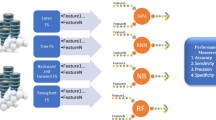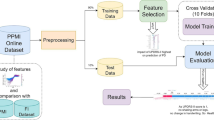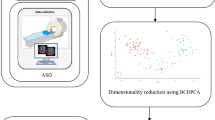Abstract
Parkinson’s disease is a progressive neural disorder that affects the central as well as the entire nervous system. The major symptoms of the disease are difficulty in walking, slowness in movement, and difficulty in coordinating with brain and body movements. It involves various other complications including depression and sleeping disorders. There are various causes for Parkinson's disease such as environmental factors, genetics, and more. With the technological growth, machine learning techniques have been employed in various fields including health care in many aspects. Owing to the advantage of machine learning techniques, this paper presents the model that selects the significant features among various attributes from Parkinson’s dataset. The proposed method employs multiple ranks with a majority vote-based relative aggregate scoring method for selecting key features among various features that contribute toward the disease among patients. The proposed method ranks the attributes using various methods with various weights which are computed based on the accuracy of the method, and the obtained ranks are then converted to scores based on the obtained majority votes. The results obtained from the methods for each attribute are computed using the relative aggregate score approach from which the attributes having the highest average score are selected. The proposed model provides better results in selecting the most imperative attribute from the underlying Parkinson dataset. The experimental analysis has been made with three datasets from which it is clear that the performance of the proposed model provides effective results with 91.027% of accuracy.
Access this chapter
Tax calculation will be finalised at checkout
Purchases are for personal use only
Similar content being viewed by others
References
Khan, S.U.: Classification of Parkinson’s Disease using data mining techniques. J. Parkinsons Dis Alzheimer Dis 2(1), 1–4 (2015)
Jyotsna, S.: Computational Modeling and Information Processing of Firing Patterns in Parkinson Disease. Thesis Dissertation, The Northcap University (Formerly ITM University, Gurgaon), (2017)
De Lau, L.M., Breteler, M.M.: Epidemiology of Parkinson’s disease. The Lancet Neurol. 5(6), 525–535 (2006)
Ho, A.K., Iansek, R., Marigliani, C., Bradshaw, J.L., Gates, S.: Speech impairment in a large sample of patients with Parkinson’s disease. Behav. Neurol. 11(3), 131–137 (1998)
Sadek, R.M., Mohammed, S.A., Abunbehan, A.R.K., Ghattas, A.K.H.A., Badawi, M.R., Mortaja, M.N., Abu-Nasser, B.S., Abu-Naser, S.S.: Parkinson’s disease prediction using artificial neural network. Int. J. Acad. Health Med. Res. 3(1), 1–8 (2019)
Cai, Z., Gu, J., Wen, C., Zhao, D., Huang, C., Huang, H., Tong, C., Li, J., Chen, H.: An intelligent Parkinson’s disease diagnostic system based on a chaotic bacterial foraging optimization enhanced fuzzy KNN approach. Comput. Math. Methods Med. pp. 1–24 (2018)
Choi, H., Ha, S., Im, H.J., Paek, S.H., Lee, D.S.: Refining diagnosis of Parkinson's disease with deep learning-based interpretation of dopamine transporter imaging. NeuroImage: Clin. 16, 586–594 (2017)
Nagasubramanian, G., Sankayya, M., Al-Turjman, F., Tsaramirsis, G.: Parkinson data analysis and prediction system using multi-variant stacked auto encoder. IEEE Access 8, 127004–127013 (2020)
Shrivastava, P., Shukla, A., Vepakomma, P., Bhansali, N., Verma, K.: A survey of nature-inspired algorithms for feature selection to identify Parkinson’s disease. Comput. Methods Programs Biomed. 139, 171–179 (2017)
Cigdem, O., Demirel, H.: Performance analysis of different classification algorithms using different feature selection methods on Parkinson’s disease detection. J. Neurosci. Methods 309, 81–90 (2018)
Aich, S., Kim, H.C., Hui, K.L., Al-Absi, A.A., Sain, M.: A supervised machine learning approach using different feature selection techniques on voice datasets for prediction of Parkinson’s disease. In International Conference on Advanced Communication Technology (ICACT), pp. 1116–1121. IEEE (2019)
Spadoto, A.A., Guido, R.C., Carnevali, F.L., Pagnin, A.F., Falcão, A.X., Papa, J.P.: Improving Parkinson's disease identification through evolutionary-based feature selection. In Annual International Conference of the IEEE Engineering in Medicine and Biology Society, pp. 7857–7860. IEEE (2011)
Ali, L., Zhu, C., Zhou, M., Liu, Y.: Early diagnosis of Parkinson’s disease from multiple voice recordings by simultaneous sample and feature selection. Expert Syst. Appl. 137, 22–28 (2019)
Sathya Bama, S., Saravanan, A.: Efficient classification using average weighted pattern score with attribute rank based feature selection. Int. J. Intell. Syst. Appl. 10(7), 29–42 (2019)
Rajaleximi, P., Ahmed, M., Alenezi, A.: Feature selection using optimized multiple rank score model for credit scoring. Int. J. Intell. Eng. Syst. 12(04), 74–84 (2019)
Hall, M.A.: Correlation-based feature selection of discrete and numeric class machine learning. Working paper, University of Waikato, Hamilton, New Zealand (2000)
Priyadarsini, R.P., Valarmathi, M.L., Sivakumari, S.: Gain ratio based feature selection method for privacy preservation. ICTACT J. Soft Comput. 1(4), 201–205 (2011)
Azhagusundari, B., Thanamani, A.S.: Feature selection based on information gain. Int. J. Innovative Technol. Explor. Eng. 2(2), 18–21 (2013)
Robnik-Šikonja, M., Kononenko, I.: An adaptation of relief for attribute estimation in regression. Proc. Fourteenth Int. Conf. Mach. Learn. 5, 296–304 (1997)
Kannan, S.S., Ramaraj, N.: A novel hybrid feature selection via symmetrical uncertainty ranking based local memetic search algorithm. Knowl. Based Syst. 23(6), 580–585 (2010)
García, S., Luengo, J., Herrera, F.: Data Preprocessing in Data Mining, vol. 72. Springer International Publishing, Cham, Switzerland (2015)
Sim, J., Lee, J.S., Kwon, O.: Missing values and optimal selection of an imputation method and classification algorithm to improve the accuracy of ubiquitous computing applications. Mathematical Problems in Engineering, 1–14 (2015)
Schenker, N., Taylor, J.M.: Partially parametric techniques for multiple imputation. Comput. Stat. Data Anal. 22(4), 425–446 (1996)
Horton, N.J., Lipsitz, S.R.: Multiple imputation in practice: comparison of software packages for regression models with missing variables. Am. Stat. 55(3), 244–254 (2001)
Yang Y., Webb G.I., Wu X.: Discretization Methods. In: Maimon O., Rokach L. (eds.) Data Mining and Knowledge Discovery Handbook. Springer, Boston, MA (2009)
Jo, J.M.: Effectiveness of normalization pre-processing of big data to the machine learning performance. J. Korea Inst. Electron. Commun. Sci. 14(3), 547–552 (2019)
Sathya Bama, S., Ahmed, M.I., Saravanan, A.: Improved pagerank algorithm for web structure mining. Int. J. Comput. Technol. 10(9), 1969–1976 (2013)
Sathya Bama, S., Ahmed, I., Saravanan, A.: A Mathematical approach for improving the performance of the search engine through web content mining. J. Theor. Appl. Inf. Technol. 60(2), 343–350 (2014)
Kong, D., Cen, L.: Mobile App Risk Ranking via Exclusive Sparse Coding. In The World Wide Web Conference, pp. 2922–2928 (2019)
Dua, D., Graff, C.: UCI Machine Learning Repository, http://archive.ics.uci.edu/ml. Irvine, CA: University of California, School of Information and Computer Science (2019)
Little, M., McSharry, P., Roberts, S., Costello, D., Moroz, I.: Exploiting nonlinear recurrence and fractal scaling properties for voice disorder detection. Nature Precedings, pp. 1–35 (2007)
Sakar, C.O., Serbes, G., Gunduz, A., Tunc, H.C., Nizam, H., Sakar, B.E., Tutuncu, M., Aydin, T., Isenkul, M.E., Apaydin, H.: A comparative analysis of speech signal processing algorithms for Parkinson’s disease classification and the use of the tunable Q-factor wavelet transform. Appl. Soft Comput. 74, 255–263 (2019)
Sakar, B.E., Isenkul, M.E., Sakar, C.O., Sertbas, A., Gurgen, F., Delil, S., Apaydin, H., Kursun, O.: Collection and analysis of a Parkinson speech dataset with multiple types of sound recordings. IEEE J. Biomed. Health Inform. 17(4), 828–834 (2013)
Bama, S.S., Ahmed, M.I., Saravanan, A.: A survey on performance evaluation measures for information retrieval system. Int. Res. J. Eng. Technol. 2(2), 1015–1020 (2015)
Author information
Authors and Affiliations
Editor information
Editors and Affiliations
Rights and permissions
Copyright information
© 2022 The Author(s), under exclusive license to Springer Nature Singapore Pte Ltd.
About this paper
Cite this paper
Gopalsamy, A., Radha, B. (2022). Feature Selection Using Multiple Ranks with Majority Vote-Based Relative Aggregate Scoring Model for Parkinson Dataset. In: Saraswat, M., Roy, S., Chowdhury, C., Gandomi, A.H. (eds) Proceedings of International Conference on Data Science and Applications. Lecture Notes in Networks and Systems, vol 287. Springer, Singapore. https://doi.org/10.1007/978-981-16-5348-3_1
Download citation
DOI: https://doi.org/10.1007/978-981-16-5348-3_1
Published:
Publisher Name: Springer, Singapore
Print ISBN: 978-981-16-5347-6
Online ISBN: 978-981-16-5348-3
eBook Packages: Intelligent Technologies and RoboticsIntelligent Technologies and Robotics (R0)




